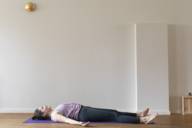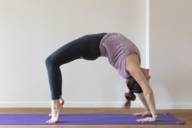
Yoga has reached all four corners of the Earth – and since it is practised a little differently in each place, we got together with yoga instructor Sandra Zavaglia to come up with a few Munich-inspired poses. A flow for everyone who loves this city as much as we do.
The “Zugspitze”, the “Frauenkirche”, the “Eisbach surfer” – together with yoga instructor Sandra Zavaglia, we have developed a handful of asanas that truly reflect the city. Born and raised in Munich, she loves this city – and yoga as well, of course: she began practising in 2008 and completed her training ten years later. Today she leads classes in the small, intimate Santosa Yoga studio in Giesing.
Walking through Munich, you’ll quickly notice that it is a city of dog lovers – and the dachshund is one of the most popular breeds here. No wonder then that a dachshund was even the mascot for the 1972 Olympic Games. The dachshund has long been considered the classic Bavarian dog breed; once used as a hunting dog by the nobility, it is now more likely to be seen frolicking around street cafés in the city centre. Its diminutive size makes it the perfect city dog, while its charming character makes it the perfect companion – it has been said that dachshunds are every bit as unconventional as the people of Munich themselves. So of course it deserves a yoga pose of its own – this one inspired by pee-time!
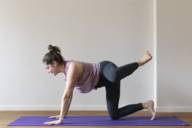
Munich without mountains – simply inconceivable. If you really want to understand the city, you probably won’t find the answer here, but instead somewhere between the A8 and the A95: a defining grace of Munich is the possibility of getting yourself to a secluded summit within the hour, when the urge takes you. And if you’ve ever done it, you’ll understand why people in the city get up so early to cram themselves onto the U-Bahn with the skiers, and why many are happy to live close to the autobahn. Our Zugspitze asana is a perfect warm-up you.
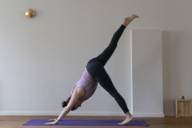
Though Hamburg actually has a larger Porsche-driving population, Munich has nonetheless gained a reputation as a hotspot for the jet set. And the stereotype does ring true to a certain extent – as you’ll soon see if you take a stroll along Maximilianstrasse. Designer boutiques stand alongside chic restaurants, while expensive cars cruise past affluent characters sporting huge sunglasses and sitting under huge parasols. The wealthy side of the city is an integral part of the place – which is why Porsche drivers have been a Munich cliché for decades. This pose is derived from Boat pose (Navasana) and is very good for the abdominal muscles.
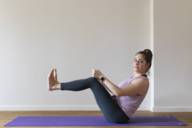
Just as winter sports fans toting ski equipment are a common sight on public transport in Munich, so too will you often spot surfers cycling through the city at every time of year and all hours of the day, all headed for the same destination: the Eisbachwelle river wave on the hill by the Haus der Kunst art gallery. River surfing as a popular sport in Munich is nothing new – in fact it is almost exactly 50 years since Munich surfer Arthur Pauli became the first person to surf the wave at the Flosslände raft landing stage, and many have since followed his example. Sandra has based the Surfer pose on the familiar Warrior pose, though this one is a little more relaxed – after all, we’re still on the Eisbach!
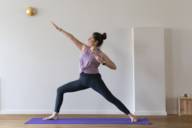
When people from Munich are asked about their city while on holiday, the conversation invariably turns to FC Bayern or Oktoberfest. There is probably scarcely a single country left on earth that has not heard of the world’s largest folk festival. But whether the millions of guests flocking to the festival year after year have a good time is hugely dependent on the servers working at the Wiesn: they carry up to 300 mugs beer per day – and if things go well, they can earn up to 10,000 euros in two weeks. So it is no coincidence that this yoga pose is inspired by the Goddess pose.
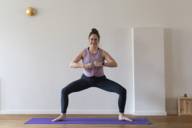
The Mittlere Ring (central ring), as Munich locals call it, connects the city like a ring road and is one of the most congested routes in all of Germany. And that’s why in Munich, your heart sinks at the sentence “Ich steh’ am Ring” (“I’m stuck on the ring”). Almost all autobahns join the Bundesstrasse (national highway) 2 R, and locals also take it to get from one part of the city to the other more quickly. In our yoga stance we focused on the body’s “central ring” of the waistline, which is abundant all year round thanks to the delicious traditional fare that Munich does so well.
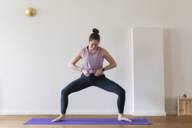
We move on to the Goalie – after all, as we’ve already noted, Munich and football is an eternal love story. Not only does FC Bayern have its home ground at the Allianz Arena football stadium in the north of the city, the team also has a training ground in the south of Munich – not far from Grünwalder Stadion, home of Munich football stalwarts TSV 1860 Munich. With a little luck then, you might even spot one or two footballers in Munich – and so this yoga pose is an homage to Neuer, Kahn and co.
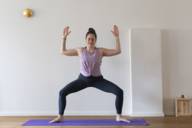
If you try to picture Munich in your mind’s eye, the Frauenkirche immediately comes to mind – it is the ultimate emblem of the city. For one thing, the church is situated in the historic Altstadt district; secondly it is the tallest building in the city centre. Its onion domes, which invoke a Middle Eastern flair, are another thing that makes the church a very special building, as their design was inspired by a temple in Jerusalem. Sandra has derived the Frauenkirche pose from the yoga pose known as the Tree. For better balance, she recommends fixing your gaze on a stationary point.
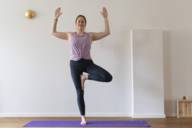
That useful tip is also handy for the next exercise, as the Chinesischer Turm (Chinese Tower) is all about balance. The famous tower in the middle of Englischer Garten (park) was constructed at the end of the 18th century, its design inspired by the ornate pagodas seen in many Asian countries. Today the tower is only accessible to the brass bands that play there – but even just sitting underneath it with a beer, or recreating it in your yoga practice is a beautiful enough experience in itself.
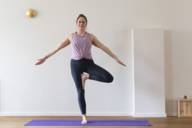
There are over a thousand bridges and footbridges in Munich – some largely undiscovered secrets and others world-renowned, like the Donnersberger Brücke, one of the most important bridges in the city. Around 350,000 people pass over the bridge every day as they travel into or out of Munich by train or S-Bahn. The Mittlere Ring also passes over it, making it one of the most important transportation hubs in the city. If the Wheel pose is a little too challenging for you, you could try our Bridge instead, by raising your legs while your head and shoulders remain on the floor.

In Paris you pick up a croissant for your morning snack, while in Munich you grab a weisswurst. Butchers all over the city start making these sausages early in the morning, and then they are sold at markets and in traditional inns. The rule that you shouldn’t eat weisswurst after midday comes from a time when people didn’t have fridges and there was a risk that the sausage might quickly go off. Things are different now of course, but the rule persists. Weisswurst has become internationally known through festivals such as Munich’s Fasching (Carnival) and of course Oktoberfest! The Weisswurst yoga pose is inspired by the Butterfly stretch and the Star pose.
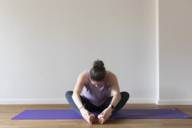
And what must you always have alongside your weisswurst? A pretzel, of course! You’ll find oversized versions at Oktoberfest as well as in the beer gardens – and our chef Sven Christ can even show you how to easily make a proper giant pretzel of your own. This lye bread speciality is now so firmly established as a staple in the Bavarian capital that everyone here grows up with it. And pretzels fit so nicely in a child’s hand, too! By the time you’re a grown-up, you’ll have found your favourite pretzel in Munich after years of diligently trying the many different options on offer. The Lotus position on which our Pretzel pose is based is at least as difficult as choosing your favourite pretzel – beginners in particular should only go as far as is comfortable.
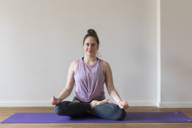
The naturist movement has enjoyed huge popularity in Munich since the 70s. It originated in the era of the 1968 student movement, sexual liberation and the hippy generation, all of which were particularly prevalent in Schwabing and the Englischer Garten in particular. Nude bathing is still permitted in designated areas around the Eisbach, and the most popular nudist beach is situated along the southern part of the Isar river. So you may find yourself strolling along the Flauchersteg while others lie naked and soaking up the sun below. Shavasana, our final pose, is similarly relaxing.
